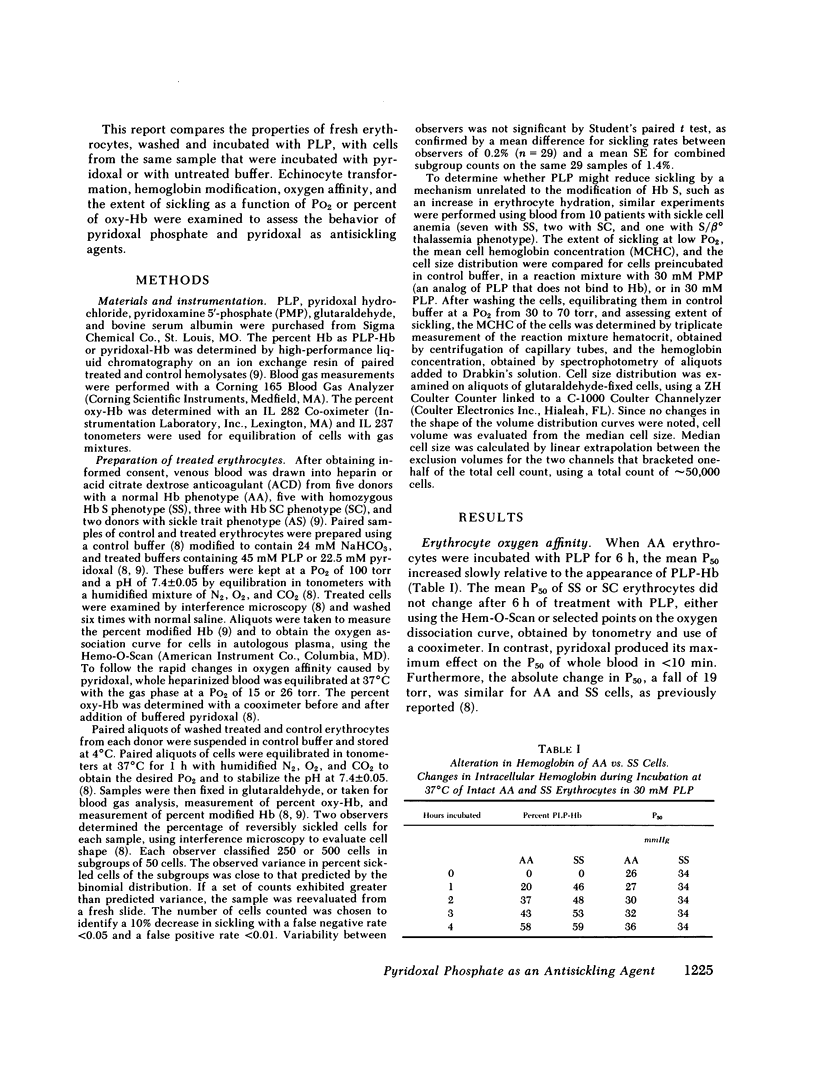Abstract
Although pyridoxal phosphate is known to inhibit gelation of purified hemoglobin S, antisickling activity has never been demonstrated for intact erythrocytes. We incubated washed erythrocytes at 37 degrees C either in buffer alone, or with added pyridoxal phosphate or pyridoxal, washed these cells, suspended them in untreated buffer, and compared the percent modified hemoglobin, the oxygen affinity, and the extent of sickling under hypoxia. Pyridoxal phosphate modified intracellular hemoglobin more slowly than pyridoxal. Pyridoxal phosphate lowered the oxygen affinity of normal cells, but had no effect on oxygen binding by sickle cells. Pyridoxal increased the oxygen affinity of normal and sickle erythrocytes equally. Pyridoxal phosphate significantly inhibited sickling of sickle or sickle trait erythrocytes (P less than 0.001). Inhibition of sickling by pyridoxal phosphate was largely independent of oxygen binding; whereas inhibition of sickling by pyridoxal was almost entirely dependent on increased oxygen binding. Although pyridoxal phosphate and pyridoxal both inhibit sickling by modification of hemoglobin S, they differ in the kinetics of whole cell modification, the effect on oxygen affinity of intact cells, and the mechanism of action of the antisickling activity.
Full text
PDF





Selected References
These references are in PubMed. This may not be the complete list of references from this article.
- Arnone A., Benesch R. E., Benesch R. Structure of human deoxyhemoglobin specifically modified with pyridoxal compounds. J Mol Biol. 1977 Oct 5;115(4):627–642. doi: 10.1016/0022-2836(77)90107-3. [DOI] [PubMed] [Google Scholar]
- Benesch R. E., Edalji R., Kwong S., Benesch R. Oxygen affinity as an index of hemoglobin S polymerization: a new micromethod. Anal Biochem. 1978 Aug 15;89(1):162–173. doi: 10.1016/0003-2697(78)90737-6. [DOI] [PubMed] [Google Scholar]
- Benesch R. E., Yung S., Suzuki T., Bauer C., Benesch R. Pyridoxal compounds as specific reagents for the alpha and beta N-termini of hemoglobin. Proc Natl Acad Sci U S A. 1973 Sep;70(9):2595–2599. doi: 10.1073/pnas.70.9.2595. [DOI] [PMC free article] [PubMed] [Google Scholar]
- Benesch R., Benesch R. E., Edalji R., Suzuki T. 5'-deoxypyridoxal as a potential anti-sickling agent. Proc Natl Acad Sci U S A. 1977 Apr;74(4):1721–1723. doi: 10.1073/pnas.74.4.1721. [DOI] [PMC free article] [PubMed] [Google Scholar]
- Benesch R., Benesch R. E., Kwong S., Acharya A. S., Manning J. M. Labeling of hemoglobin with pyridoxal phosphate. J Biol Chem. 1982 Feb 10;257(3):1320–1324. [PubMed] [Google Scholar]
- Benesch R., Benesch R. E. Preparation and properties of hemoglobin modified with derivatives of pyridoxal. Methods Enzymol. 1981;76:147–159. doi: 10.1016/0076-6879(81)76123-8. [DOI] [PubMed] [Google Scholar]
- Benesch R., Benesch R. E., Yung S. Chemical modifications that inhibit gelation of sickle hemoglobin. Proc Natl Acad Sci U S A. 1974 Apr;71(4):1504–1505. doi: 10.1073/pnas.71.4.1504. [DOI] [PMC free article] [PubMed] [Google Scholar]
- Harkness D. R., Roth S. Clinical evaluation of cyanate in sickle cell anemia. Prog Hematol. 1975;9:157–184. [PubMed] [Google Scholar]
- Ink S. L., Mehansho H., Henderson L. M. The binding of pyridoxal to hemoglobin. J Biol Chem. 1982 May 10;257(9):4753–4757. [PubMed] [Google Scholar]
- KRAFT H. G., FIEBIG L., HOTOVY R. [On the pharmacology of vitamin B6 and its derivatives]. Arzneimittelforschung. 1961 Oct;11:922–929. [PubMed] [Google Scholar]
- Kark J. A., Bongiovanni R., Hicks C. U., Tarassoff P. G., Hannah J. S., Yoshida G. Y. Modification of intracellular hemoglobin with pyridoxal and pyridoxal 5'-phosphate. Blood Cells. 1982;8(2):299–314. [PubMed] [Google Scholar]
- Kark J. A., Kale M. P., Tarassoff P. G., Woods M., Lessin L. S. Inhibition of erythrocyte sickling in vitro by pyridoxal. J Clin Invest. 1978 Oct;62(4):888–891. doi: 10.1172/JCI109202. [DOI] [PMC free article] [PubMed] [Google Scholar]
- Maeda N., Takahashi K., Aono K., Shiga T. Effect of pyridoxal 5'-phosphate on the oxygen affinity of human erythrocytes. Br J Haematol. 1976 Nov;34(3):501–509. doi: 10.1111/j.1365-2141.1976.tb03596.x. [DOI] [PubMed] [Google Scholar]
- May A., Huehns E. R. The concentration dependence of the oxygen affinity of haemoglobin S. Br J Haematol. 1975 Jul;30(3):317–335. doi: 10.1111/j.1365-2141.1975.tb00548.x. [DOI] [PubMed] [Google Scholar]
- Nigen A. M., Njikam N., Lee C. K., Manning J. M. Studies on the mechanism of action of cyanate in sickle cell disease. Oxygen affinity and gelling properties of hemoglobin S carbamylated on specific chains. J Biol Chem. 1974 Oct 25;249(20):6611–6616. [PubMed] [Google Scholar]
- Rothstein A., Cabantchik Z. I., Knauf P. Mechanism of anion transport in red blood cells: role of membrane proteins. Fed Proc. 1976 Jan;35(1):3–10. [PubMed] [Google Scholar]
- Uvelli D. A., Lee M. Y., Manning J. M., Hlastala M. P., Babb A. L. Measurement of the carbamylation kinetics and antisickling mechanism in hemoglobin S blood. J Lab Clin Med. 1980 May;95(5):748–758. [PubMed] [Google Scholar]
- Zaugg R. H., Walder J. A., Klotz I. M. Schiff base adducts of hemoglobin. Modifications that inhibit erythrocyte sickling. J Biol Chem. 1977 Dec 10;252(23):8542–8548. [PubMed] [Google Scholar]


